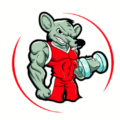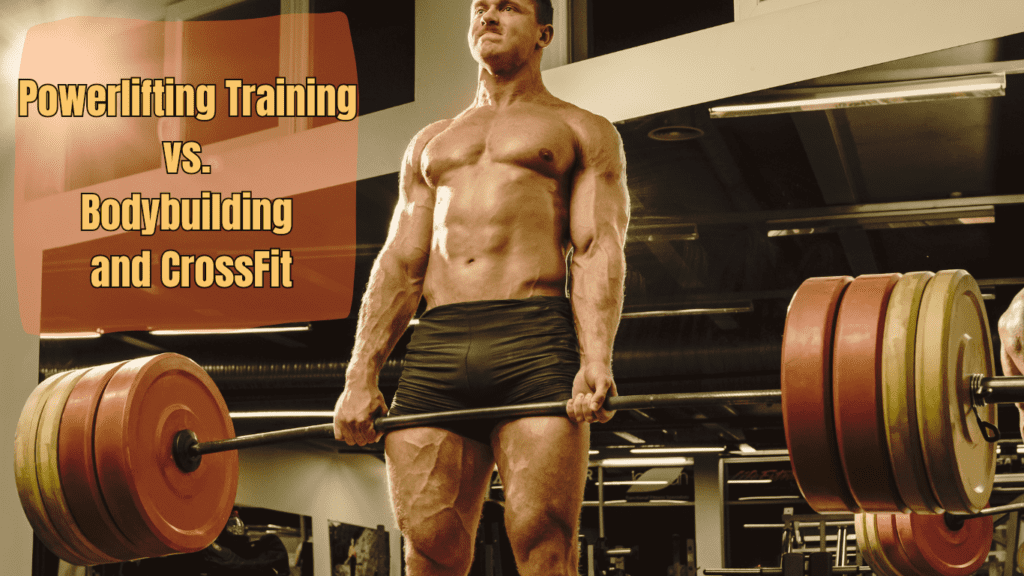How to Be a Powerlifter: The Ultimate Guide from Beginner to Pro
In this article, we’ll take you through a comprehensive, step-by-step guide on how to be a powerlifter, covering everything from the fundamentals of training as a beginner to advanced techniques, mental strategies, and competition preparation, all the way to becoming a professional in the sport. Whether you’re just starting or aiming for elite status, this guide will equip you with the knowledge and tools you need to succeed at every stage of your powerlifting journey.
Powerlifting is a strength-focused sport that revolves around three main lifts: squat, bench press, and deadlift. Unlike bodybuilding, which prioritises muscle size and aesthetics, or Olympic weightlifting, which involves explosive movements, powerlifting is all about lifting the heaviest weight possible in these three movements. It’s a test of pure strength, proper technique, and consistency. If you’ve ever wondered how to be a powerlifter, this guide will take you through every step, from your first training session to competing at a professional level.
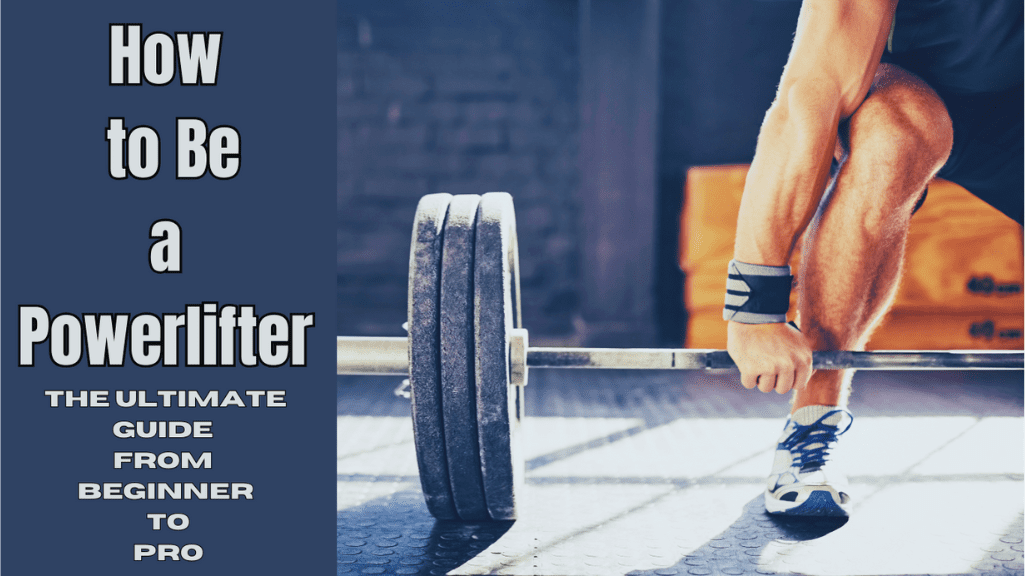
Why Powerlifting?
Powerlifting isn’t just about getting stronger—it teaches discipline, resilience, and patience. Many lifters start because they want to build strength, but they stay because of the mental and physical transformation the sport brings. You push your limits, set new personal records, and become part of a supportive community that thrives on progress and competition. Whether you aim to compete or simply want to get stronger and more confident, powerlifting offers a structured, measurable way to achieve it.
Subscribe And Get Our Free E-Book:Unlocking The Power Of Nutrition-Supplements, Substitutes, and Superfoods!
Who Is This Guide For?
This guide is for anyone curious about how to be a powerlifter, whether you’re a complete beginner or someone who wants to take training more seriously. Maybe you’ve never touched a barbell before, or maybe you’ve been lifting casually but want to follow a structured plan. Even if your goal is to reach a professional level, this guide will break down every essential step so you can progress safely and effectively.
What to Expect in This Guide
In the next parts, we will cover everything you need to know step by step:
- How to train properly: Understanding technique, programming, and recovery.
- The best way to eat for powerlifting: Nutrition for strength and performance.
- The mindset of a powerlifter: Staying motivated and pushing past plateaus.
- How to compete: The process of preparing for your first meet and beyond.
If you’ve ever thought about how to be a powerlifter, this guide will show you exactly how to do it—from beginner to pro. Stay tuned for the next part, where we’ll dive into how to start training the right way.
How to Be a Powerlifter: The Fundamentals of Strength and Competition
Powerlifting is a strength-based sport that revolves around three main lifts: squat, bench press, and deadlift (SBD). The objective is straightforward—lift as much weight as possible for a single repetition in each movement. Unlike bodybuilding, which prioritises muscle size and aesthetics, or endurance training, which focuses on stamina, powerlifting is purely about maximal strength. If you’re wondering how to be a powerlifter, the first thing to understand is how these three lifts work and how they fit into the sport.
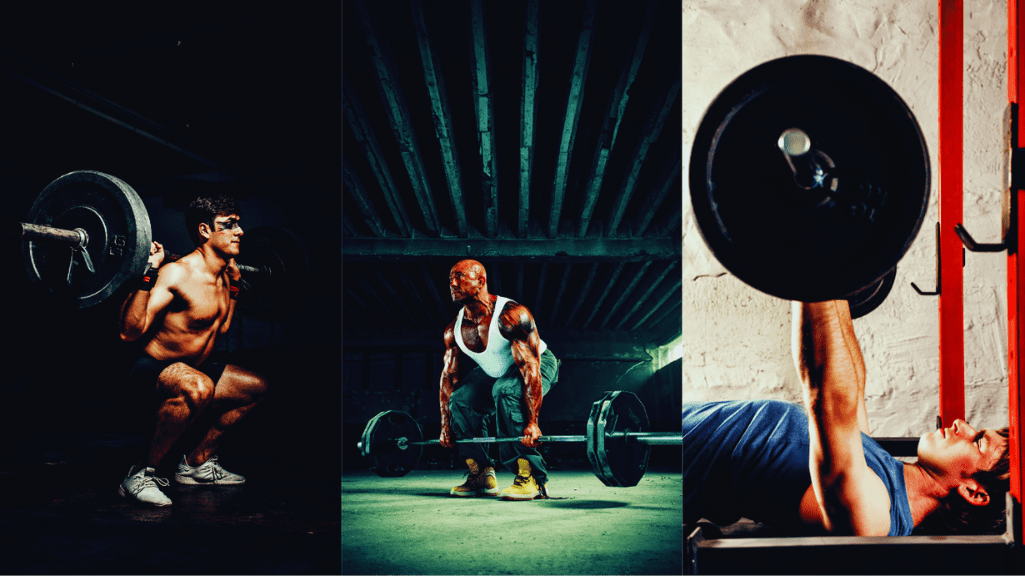
The Three Main Lifts
- Squat: A test of leg strength, core stability, and mobility. The lifter lowers their body until the hip crease drops below the knee, then drives back up to a standing position. Proper technique is essential to lift heavier weights safely and efficiently.
- Bench Press: A measure of upper body strength, especially in the chest, shoulders, and triceps. The barbell is lowered to the chest, paused briefly, and then pressed back to full extension.
- Deadlift: The ultimate display of raw power. The lifter pulls a loaded barbell from the floor to a fully locked-out position, maintaining control before lowering it back down. This movement engages almost every muscle group.
Powerlifting Competition Basics
If you’re serious about learning how to be a powerlifter, understanding how competitions work is key. Powerlifting meets are run by different federations, such as IPF, USAPL, and WRPF, each with its own set of rules. However, the general format remains the same:
- Weight Classes: Lifters compete against others of similar body weight. This ensures fairness, as strength is compared relative to body size.
- Attempts Per Lift: Each competitor gets three attempts per lift, with the heaviest successful lift in each being added together for a total score.
- Raw vs. Equipped Lifting: In raw powerlifting, lifters can only use basic supportive gear like knee sleeves and a belt. In equipped lifting, special gear like squat suits and bench shirts allow for heavier lifts.
Strength vs. Size vs. Endurance
Powerlifting focuses on pure strength, not muscle size or endurance. Understanding the difference between these training styles is crucial:
- Strength Training (Powerlifting): Heavy weights, low reps (1-5 per set), long rest periods. The goal is to lift the heaviest weight possible.
- Muscle Growth (Bodybuilding): Moderate weights, higher reps (8-15 per set), shorter rest periods. The goal is to increase muscle size rather than strength.
- Endurance Training: Lighter weights, very high reps, often combined with cardio. This type of training is designed to improve stamina rather than strength.
If you are learning how to be a powerlifter, the key takeaway is that strength is a skill. It requires technical precision, structured training, and proper recovery. Unlike bodybuilding, where appearance matters, powerlifting is judged solely on performance. A lifter with superior technique and training can often outlift someone much larger.
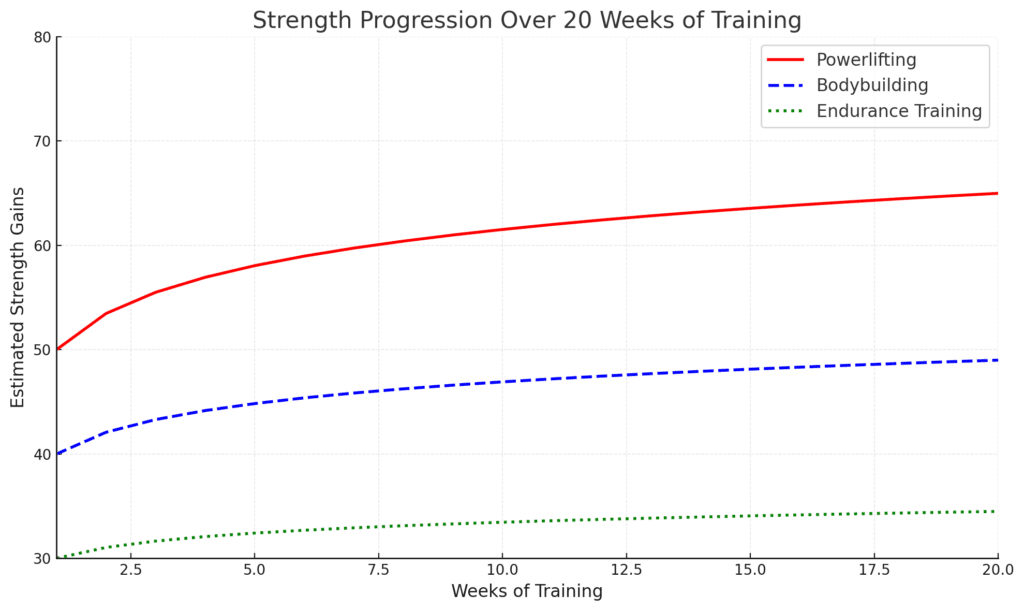
Now that you understand the fundamentals, the next part of this guide will focus on how to train effectively. We will cover proper technique, training programs, and how to progressively build strength over time.
How to Be a Powerlifter: Building a Strong Foundation in Your First Six Months
When learning how to be a powerlifter, the first six months are all about building a strong foundation. This phase is crucial because the habits you develop early on will determine your long-term success. A well-structured approach to training, nutrition, and recovery will set you on the right path.
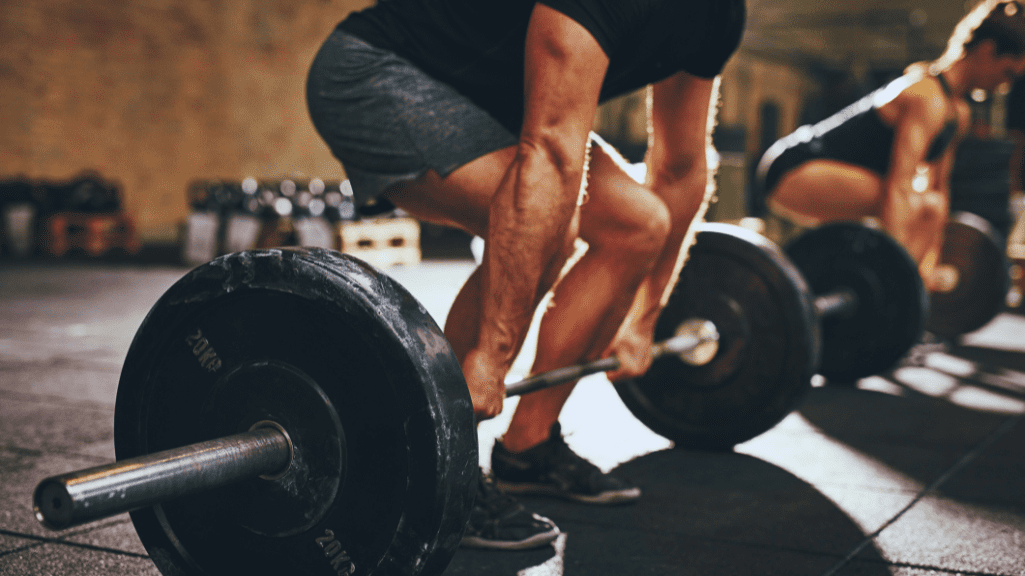
Training – Mastering the Basics
Before lifting heavy weights, it’s essential to learn proper form. Powerlifting revolves around three movements: squat, bench press, and deadlift, and each requires technical precision. Rushing into heavy weights without solid technique can lead to bad habits and potential injuries.
- Squat: Start with bodyweight squats or an empty bar to practice depth and control. Focus on keeping the feet shoulder-width apart, chest up, and knees tracking over the toes. As you progress, add weight while maintaining proper form.
- Bench Press: The key to a strong bench press is tightness and stability. Keep your feet planted, shoulder blades squeezed together, and wrists straight. Lower the bar to the middle of your chest and press up with control.
- Deadlift: Set up with your feet under the bar, grip the bar just outside your legs, and keep your back neutral. Engage your core and legs to drive the weight up while keeping the bar close to your body.
Starting with a Strength Program
Many beginners make the mistake of lifting randomly without a structured plan. If you want to know how to be a powerlifter, following a proven program is the best way to build consistent strength. Some effective beginner programs include:
- Starting Strength: Focuses on low reps, high frequency, and progressive overload. Ideal for beginners learning the big three lifts.
- StrongLifts 5×5: Simple yet effective—five sets of five reps with a focus on gradually increasing weight.
- A Beginner Powerlifting Program: A mix of low-rep strength work and accessory movements to target weak areas.
Building a Strong Base
Powerlifting isn’t just about the big three lifts. Strength comes from supporting muscles and overall body stability. Adding accessory work to your routine can help prevent weaknesses and improve overall performance.
- Core Strength: A strong core is essential for powerlifting. Exercises like planks, hanging leg raises, and ab rollouts build core stability for heavier lifts.
- Posterior Chain Work: Exercises like Romanian deadlifts, glute bridges, and hamstring curls strengthen the muscles used in squats and deadlifts.
- Mobility Training: Good mobility improves range of motion and injury prevention. Include hip stretches, shoulder mobility drills, and ankle flexibility work.
Tracking Progress
To improve, you need to track your progress. Many lifters keep a training log to record weights, reps, and sets. This helps you identify strengths, weaknesses, and plateaus. There are also apps like Strong, MyFitnessPal, and RepCount that help monitor training and nutrition.
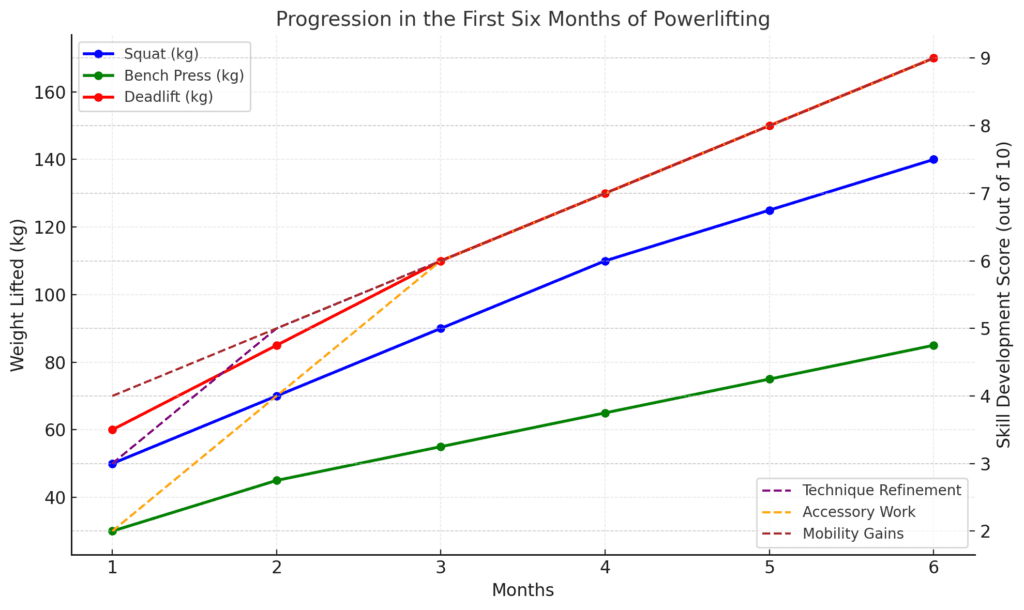
Basic Nutrition for Strength Gains
Training is only part of the equation. To build strength, you need proper nutrition. The key is to eat enough to fuel muscle growth and recovery.
- Macronutrients: A good balance of protein, carbohydrates, and fats is essential for performance.
- Caloric Surplus: To gain strength, consume more calories than you burn. This doesn’t mean eating junk food—focus on nutrient-dense foods.
- Protein Intake: Aim for 1.6–2.2g of protein per kg of body weight. Good sources include lean meats, eggs, dairy, fish, and legumes.
Recovery & Sleep – Why Rest Matters
One of the biggest mistakes beginners make is neglecting recovery. Strength gains happen outside the gym, during rest and sleep. Without proper recovery, muscle growth slows, and injuries become more likely.
- Sleep: Aim for 7–9 hours per night. Sleep is when muscle repair and growth take place.
- Rest Days: Training every day leads to burnout. Include rest days to allow your muscles to recover fully.
- Active Recovery: Activities like light stretching, walking, or yoga can help reduce stiffness and improve mobility.
Avoiding Common Mistakes
Many beginners struggle with bad habits that slow down progress. Avoid these common mistakes to stay on track:
- Ego Lifting: Trying to lift too much weight too soon leads to poor form and injuries. Focus on technique before adding weight.
- Neglecting Mobility: Stiff joints and tight muscles can limit performance. Prioritise stretching and mobility work.
- Poor Recovery: Skipping rest and sleep leads to plateaus and increased injury risk. Recovery is just as important as training.
The first six months of training lay the foundation for long-term success. If you’re serious about how to be a powerlifter, focus on building strength gradually, learning proper form, and staying consistent. In the next part, we’ll cover intermediate training strategies to take your lifts to the next level.
How to Be a Powerlifter: Intermediate Phase (6 Months – 2 Years)
By now, you’ve built a solid foundation in powerlifting, mastered the basic techniques, and started to see strength gains. The next step is refining your approach to become more efficient, powerful, and well-rounded. If you’re serious about how to be a powerlifter, this phase is where you’ll start transitioning from a beginner to a serious strength athlete.
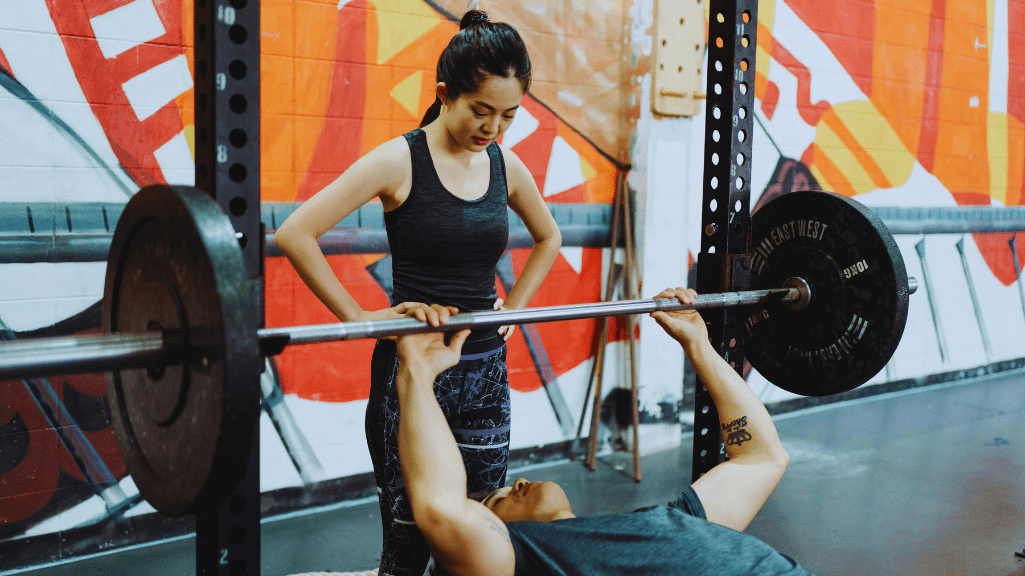
Training Progression – Moving to a Structured Powerlifting Program
In the intermediate stage, random workouts won’t cut it anymore. To keep progressing, you need a structured program that balances strength, recovery, and volume. Some of the best programs for this phase include:
- 5/3/1 (Jim Wendler’s Program): Focuses on gradual strength progression with a mix of low-rep max effort lifts and higher-rep assistance work.
- The Texas Method: A three-day-per-week program designed to build strength through heavy, medium, and light training days. Great for lifters who recover well.
- Candito’s 6-Week Program: A short but effective periodised program that cycles through hypertrophy, strength, and peaking phases.
- Reactive Training Systems (RTS): Uses auto-regulation and Rate of Perceived Exertion (RPE) to adjust training based on how you feel each session. Ideal for lifters who need more flexibility in their program.
Understanding RPE (Rate of Perceived Exertion) and Auto-Regulation
As you advance, you won’t always be able to progress in a straight line. Some days, you’ll feel stronger, while others, you’ll need to scale back. This is where RPE and auto-regulation come in.
- RPE measures effort on a scale of 1 to 10, with 10 being an absolute max effort and 6–7 being moderate intensity.
- Instead of following strict percentages, you learn to adjust your weights based on how difficult a set feels.
- This method helps prevent overtraining and reduces injury risk while still ensuring consistent progress.
Adding Variations & Fixing Weaknesses
To continue gaining strength, you need to address weak points. This means adding exercise variations to target areas that may be holding you back. Some key variations include:
- Paused Squats – Helps improve stability and control by forcing you to hold the bottom position before standing up.
- Deficit Deadlifts – Performed by standing on a small platform, increasing the range of motion and strengthening the initial pull.
- Close-Grip Bench Press – A great way to build triceps strength, which helps improve lockout in the bench press.
- Front Squats – Strengthens the quadriceps and core, improving squat performance and overall leg strength.
Deloading & Injury Prevention
One mistake many lifters make is pushing too hard for too long. If you want to know how to be a powerlifter for the long haul, you must prioritise recovery. This is where deloading comes in.
- Deload Weeks: Every 4 to 8 weeks, reduce training intensity by 20-50% to allow your muscles, joints, and nervous system to recover.
- Listen to Your Body: If you’re constantly sore, fatigued, or struggling with motivation, it may be time to back off for a few days.
- Prehab & Mobility Work: Include foam rolling, stretching, and mobility drills before and after training to keep joints healthy and movement smooth.
Advanced Nutrition – Fueling Your Strength
By now, you should have a basic understanding of macronutrients. But at this stage, fine-tuning your diet can make a big difference in performance.
- Carb Timing: Eating complex carbs (rice, oats, potatoes) before training provides energy, while fast-digesting carbs (fruits, honey, sports drinks) during or after a session help with recovery.
- Hydration: Even slight dehydration can impact strength and endurance. Drink at least 3–4 litres of water daily, more if sweating heavily.
- Supplementation: While food should always be the priority, supplements like creatine monohydrate, whey protein, and electrolytes can support performance and recovery.
Mobility & Prehab – Avoiding Injuries
Lifting heavier weights puts more stress on the body. If you ignore mobility and prehab, you increase the risk of injuries that can derail progress. Key strategies include:
- Proper Warm-Ups: Instead of jumping straight into heavy sets, perform dynamic stretches, bodyweight movements, and light warm-up sets.
- Foam Rolling & Soft Tissue Work: Helps reduce tightness, improve blood flow, and keep muscles and joints moving smoothly.
- Stretching: Focus on areas like hips, shoulders, hamstrings, and ankles to maintain full range of motion in your lifts.
Mental Strength & Motivation – Pushing Through Plateaus
Progress in powerlifting isn’t always linear. At some point, you will hit a plateau. The key to overcoming these challenges is mental toughness.
- Trust the Process: Gains slow down over time, but sticking to your program and being consistent is what leads to long-term success.
- Break Plateaus with Small Wins: If your main lifts aren’t improving, look for progress in accessory work, technique, or rep PRs.
- Stay Motivated: Training can sometimes feel repetitive. Keep things interesting by setting short-term goals, tracking progress, and surrounding yourself with supportive training partners.
Joining a Powerlifting Gym or Team
Lifting alone can be effective, but training in a powerlifting gym or with a team can take you further.
- Coaching & Feedback: Having a knowledgeable coach or experienced lifters around helps refine your technique and programming.
- Accountability & Motivation: Training partners push you to show up, work hard, and stay disciplined.
- Meet Preparation: If you’re planning to compete, being in a supportive environment helps with meet day strategy, confidence, and execution.
The intermediate phase is where you truly develop as a powerlifter. By following structured programming, refining your technique, improving nutrition, and staying consistent, you will continue making gains. If you’re committed to learning how to be a powerlifter, this phase is all about fine-tuning your training and preparing for advanced levels. In the next part, we’ll discuss advanced training methods, competition prep, and strategies for long-term success.
How to Be a Powerlifter: Mastering the Advanced Phase for Competitive Success
The advanced phase of powerlifting is where things get serious. By now, you’ve been training consistently for over two years, and you’re ready to take your skills to the next level. This phase will focus on custom programming, peaking for competitions, managing intensity, and handling competition nerves. It’s where your growth really accelerates, and you start preparing for the demands of competitive powerlifting.
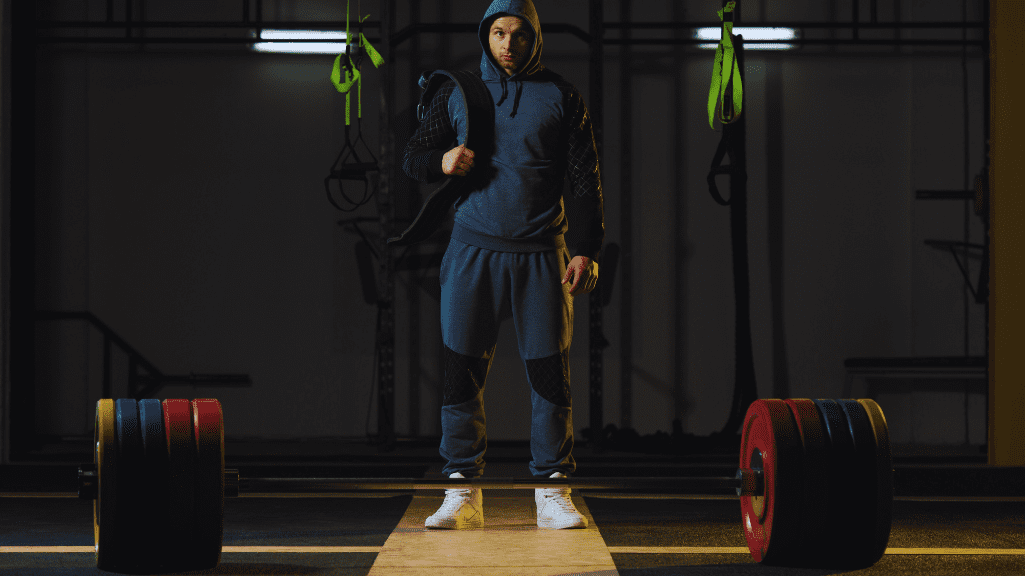
Training Like a Serious Lifter
In the advanced phase, your training needs to be specific and tailored to your individual needs. Here’s what you should focus on:
- Customised Programming: You should now be training with a programme built around your weaknesses, leverages, and recovery needs. This will help you improve specific areas that are holding back your progress.
- Volume & Intensity: You’ll start increasing both the volume and intensity of your training. This means lifting heavier weights more frequently while still maintaining proper form. You’ll also work on more advanced lifting techniques.
- Individual Focus: Consider working with a coach or a mentor who can help fine-tune your form, make adjustments to your programming, and monitor your progress. If you’re wondering how to be a powerlifter at this level, it’s all about precision and personalisation in your training.
Peaking for Competitions – Planning for Meet Day Performance
Peaking is the process of adjusting your training so that you’re at your strongest on meet day. To plan properly for competition, you’ll need to:
- Reduce Training Volume: Leading up to the competition, decrease the volume and intensity of your training sessions. This ensures that you’re well-rested and ready to perform at your best.
- Focus on Technique: As you reduce volume, focus on improving your technique and preparing for your lifts on competition day. Refine your squat, bench press, and deadlift form to perfection.
- Plan Your Attempts: Deciding on your opening, second, and third attempts can make or break your meet. With the right strategy, you can ensure that you’re pushing your limits without risking failure. It’s vital to plan wisely, so you can confidently progress through your attempts.
Increasing Training Volume & Intensity – Pushing Your Limits Safely
In the advanced stage, pushing the boundaries of your strength is essential, but it must be done safely. Increasing your training volume and intensity helps you adapt and get stronger, but you must take care not to overdo it. Here’s how you can manage this effectively:
- Gradual Progression: Increase your volume slowly to avoid injury. This means progressively adding more sets, reps, or weight each week. The goal is to gradually overload your muscles to stimulate growth.
- Listen to Your Body: The more you push yourself, the more important it is to pay attention to how your body is responding. If you feel fatigued, don’t hesitate to scale back. Rest and recovery are just as important as lifting itself.
- Monitor Recovery: In this phase, recovery becomes a critical component of your progress. Sleep, nutrition, and active recovery strategies should be your focus alongside your increased training efforts. Don’t just train harder — train smarter.
Competing in Local Meets – What to Expect and How to Prepare
Entering a local powerlifting competition is one of the best ways to test your progress and experience the atmosphere of a meet. Here’s what you can expect and how to prepare:
- Expect Nerves: It’s completely normal to feel nervous before your first competition. Handling pressure is a skill that will come with experience, but in the meantime, try to stay calm and focus on your goals for the meet.
- Understand the Rules: Each competition has its own set of rules. Make sure you’re familiar with the specifics of the event, such as the timing of lifts, the commands from the judges, and the way your attempts are organised.
- Strategy for Success: If you’re wondering how to be a powerlifter in a meet, the key is to stay consistent. Don’t get distracted by the crowd or competitors around you. Focus on your own performance and execute each lift as you’ve practiced.
Cutting & Bulking for Competition – Managing Body Weight Effectively
Managing your body weight is a huge part of competitive powerlifting. You’ll need to decide whether you want to cut or bulk based on your weight class and goals. Here’s how to approach this:
- Cutting: If you need to drop weight to fit into a specific weight class, start your cut early and focus on maintaining strength while losing fat. A slow and steady approach is best, so avoid crash diets.
- Bulking: On the other hand, if you need to add muscle mass to increase your strength, focus on eating in a calorie surplus while still prioritising clean, nutritious foods to prevent unnecessary fat gain.
- Stay Focused: Proper nutrition and hydration will play a massive role in your success, so keep these factors at the forefront of your training and competition prep.
Handling Pressure & Meet Day Nerves – Strategies for Success
Competition day can be nerve-wracking, but it’s important to manage your stress and perform at your best. Here’s how to stay calm and collected:
- Visualisation: Before the meet, take some time to visualise yourself executing your lifts successfully. This mental preparation can help calm your nerves.
- Breathing Exercises: Practice deep breathing techniques to help manage anxiety and stay focused during your attempts.
- Stay in the Moment: If you start feeling overwhelmed, remind yourself that you’ve trained for this moment. Trust in your preparation and focus on the task at hand.
- How to be a powerlifter isn’t just about physical strength; mental toughness is key to your success.
Networking in the Powerlifting Community – Coaches, Sponsors, and Social Media Presence
As you advance, it’s also important to build connections within the powerlifting community. Networking can help you grow as a lifter and even open doors for sponsorships or coaching opportunities. Here’s how to start:
- Find a Mentor or Coach: A coach can provide valuable feedback and programming tailored to your needs. Consider reaching out to coaches who specialise in competitive powerlifting to guide your journey.
- Social Media Presence: Platforms like Instagram and YouTube are fantastic for showcasing your progress. Engaging with the powerlifting community online can help you connect with other lifters, sponsors, and potential opportunities.
- Attend Local Meets: Networking at local meets is a great way to meet like-minded individuals and learn from those who’ve been through the competition experience.
In the advanced phase, how to be a powerlifter is all about putting together the mental, physical, and social elements that contribute to a well-rounded competitor.
How to Be a Powerlifter: Achieving Success as a Professional Athlete
Becoming a professional powerlifter is the next level of achievement in your lifting journey. At this stage, you’re no longer just training for personal improvement or competitions — you’re training for elite performance and managing the responsibilities that come with being an athlete at the highest level. This stage is about building a world-class training regimen, enhancing recovery, and understanding the intricacies of work-life balance. Let’s dive into how to make this transition and succeed at the top tier of powerlifting.
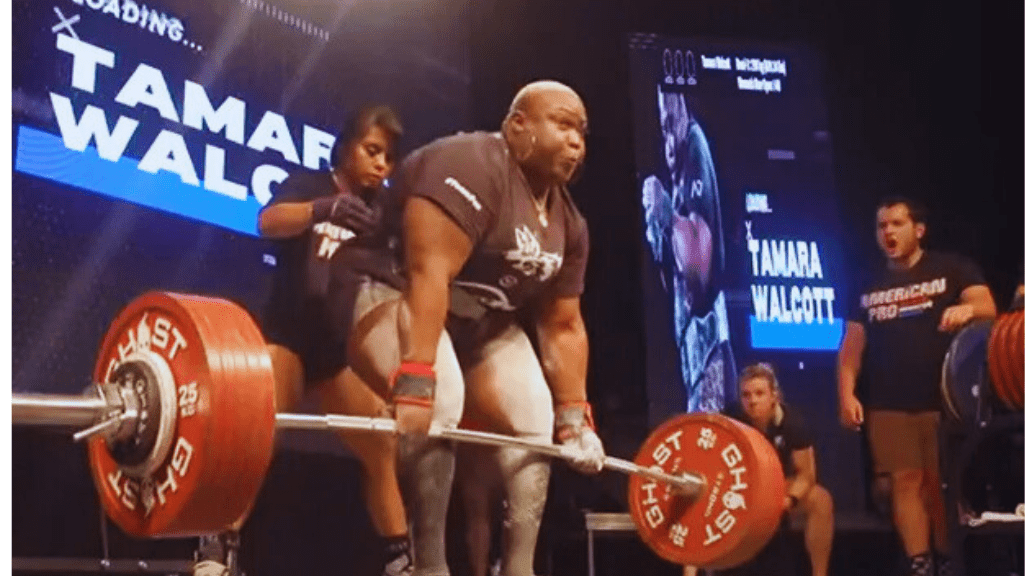
Elite-Level Training & Lifestyle
To reach the professional level in powerlifting, your training must reflect the highest standards of performance. Here’s how to fine-tune your approach:
- Custom Programming for World-Class Performance: At this stage, you’ll need a tailored training plan designed to meet your specific needs and goals. A professional powerlifter’s programme should focus on perfecting form, maximising strength, and ensuring optimal progression. You’ll work with coaches or sports scientists who understand your unique weaknesses, muscle imbalances, and strengths. If you’re wondering how to be a powerlifter at an elite level, it’s all about precision, consistency, and maximising your potential through a comprehensive training plan.
- Advanced Recovery Methods: Recovery becomes more crucial as your training intensifies. Professionals use sports massage, ice baths, and physiotherapy to recover from heavy training loads. These methods help reduce muscle inflammation, improve circulation, and speed up tissue repair. Prioritising recovery can keep you injury-free and help maintain consistent progress throughout your career.
- Managing Work-Life Balance: As a professional, you’ll face the challenge of balancing your powerlifting career with everyday life. Many powerlifters at this level have to manage work, training, travel, and personal life. It’s important to create a schedule that accommodates all these aspects, ensuring that you’re giving enough attention to your lifting while still enjoying other parts of your life. It can be a tough balancing act, but learning how to manage your time is key. If you’re wondering how to be a powerlifter and succeed long-term, finding harmony between your sport and personal life is essential.
Sponsorships & Career Opportunities
Reaching the professional powerlifter level also opens up a world of opportunities beyond just training. Here’s how you can capitalise on your success:
- How to Get Noticed by Sponsors and Secure Partnerships: Sponsorships play a huge role in the careers of professional powerlifters. Companies in the fitness industry want to work with athletes who have a strong reputation, a large following, and consistent performance. To get noticed, you need to build a personal brand, prove your worth on the platform, and engage with your audience. Start by showcasing your achievements, setting goals, and building relationships within the powerlifting community. Brands will be more likely to invest in you if they see you as a valuable partner. If you’re wondering how to be a powerlifter who attracts sponsors, consistency, personality, and results are the key factors.
- Using Social Media & Branding to Grow as an Athlete: Social media is one of the most powerful tools for professional athletes today. Platforms like Instagram, YouTube, and Twitter allow you to connect with your fans, share your progress, and showcase your lifts. To use social media effectively, it’s important to develop a strong online presence. Post regularly about your training, competitions, and even your personal life to make connections with your audience. Share valuable content like training tips, motivational posts, and your journey as a professional powerlifter. A well-managed social media account can help you gain more recognition and attract sponsorships. If you’re looking for how to be a powerlifter and expand your career, this online presence is a great tool to invest in.
Coaching & Mentoring Upcoming Powerlifters
As a professional powerlifter, you have the opportunity to give back to the community by coaching and mentoring the next generation of athletes. This can not only be financially rewarding but also allow you to share your knowledge and experience with others.
- Coaching Others: Many professional powerlifters choose to offer coaching services to help others reach their goals. Coaching allows you to leverage your experience and guide upcoming athletes through the challenges of strength training and powerlifting. This could be done in person or online, depending on your schedule. Offering coaching services can be a great way to stay connected to the sport while also building an additional stream of income.
- Mentoring Young Lifters: As a professional, you’ll also have the opportunity to mentor younger athletes. This involves offering advice, sharing your training insights, and encouraging them to stay focused on their goals. It’s about helping them avoid the mistakes you made early on and guiding them to success. When you’re wondering how to be a powerlifter and make a positive impact on the community, mentoring provides a fulfilling way to contribute.
How to Be a Powerlifter: The Path to Professional Powerlifting Success
To truly excel as a professional powerlifter, you need to take your sport seriously and approach it with a mindset of continual improvement. Here are the keys to ensuring long-term success:
- Consistency: The best powerlifters aren’t just those who lift the heaviest weights — they are the ones who consistently perform at a high level, day in and day out. This means sticking to your programme, committing to recovery, and always looking for ways to improve.
- Networking: Building relationships within the powerlifting world can open up doors for sponsorships, competitions, and coaching opportunities. Attend meets, connect with other lifters, and stay active on social media. Building a network can significantly impact your career.
- Focus on Performance: At the professional level, results are everything. While it’s important to build a personal brand, your performance on the platform should always come first. Stay focused on your training and make performance a priority if you’re aiming to be a powerlifter at the highest level.
- Stay Humble & Keep Learning: No matter how successful you become, remember that the learning never stops. Always seek ways to improve your technique, increase your knowledge, and adapt your training programme. Humility and an open mind are the foundation of sustained success in any career, including powerlifting.
Becoming a professional powerlifter is a long journey, but with the right mindset, discipline, and dedication, you can reach the pinnacle of your sport. By focusing on elite training, maximising recovery, managing your career, and mentoring others, you’ll not only thrive as an athlete but also leave a lasting impact on the powerlifting community.
How To Be A Powerlifter Video
How to Be a Powerlifter: Essential Tips, Hacks, and Overcoming Common Challenges
Powerlifting is a journey that requires consistent effort, strategic planning, and the ability to adapt to challenges along the way. If you’re wondering how to be a powerlifter and succeed in the long run, understanding the right strategies and overcoming obstacles is key. This section will provide you with essential tips for success and address common challenges that lifters face as they progress in their training. From maintaining consistent progress to overcoming injuries and mental blocks, let’s explore the best ways to navigate the world of powerlifting.
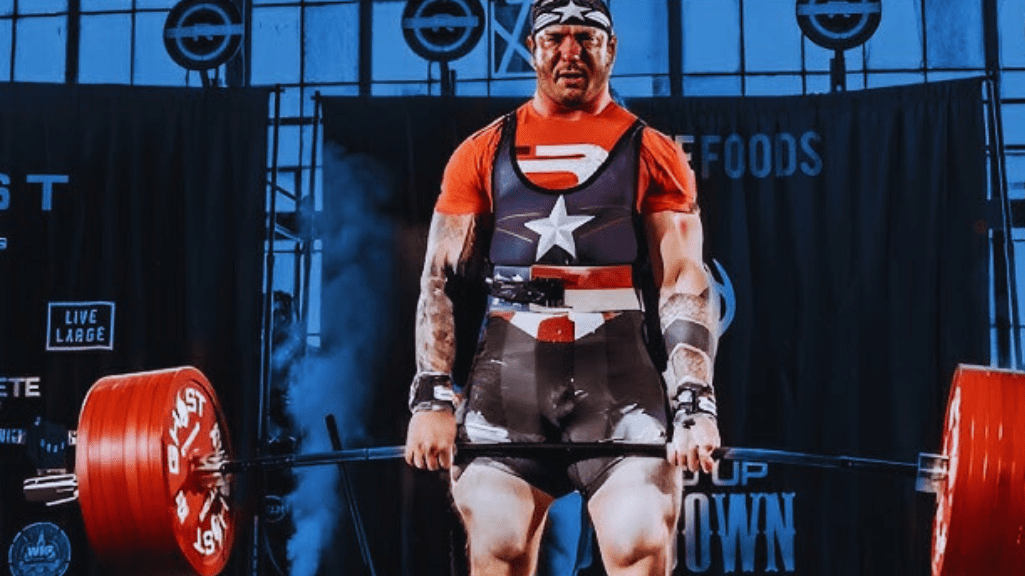
How to Be a Powerlifter: Tips for Success
Achieving success in powerlifting isn’t just about lifting heavier weights each session. It’s about building a sustainable training routine and taking care of your body, mind, and performance. Here are some key tips that can help you succeed:
- Consistency Over Intensity: One of the biggest mistakes new lifters make is focusing too much on intensity without thinking about consistency. Sure, lifting heavy weights feels good in the short term, but the real progress comes from consistent effort over time. Training regularly, without constantly pushing to max out, will help you make steady gains. So, if you’re wondering how to be a powerlifter, remember: it’s better to lift moderately but consistently than to push too hard, too fast.
- The Power of Deload Weeks and Active Recovery: Recovery is a vital part of training. One of the most effective strategies to keep progressing is to schedule regular deload weeks into your programme. These are periods where you reduce the intensity of your training to allow your body to rest and recover. Active recovery, such as light cardio or mobility exercises, can also help prevent burnout and injuries. Taking time to rest will allow you to come back stronger, so don’t underestimate the importance of recovery. Understanding how to be a powerlifter also means knowing when to take a step back and let your body heal.
- Training Smarter, Not Harder: Training harder doesn’t always equate to better results. In fact, training smarter can often be more effective. Focusing on your technique, listening to your body, and making adjustments based on your needs are all part of training smarter. If you’re always pushing yourself to the limit without proper technique, you’ll eventually hit a wall, or worse, injure yourself. Instead of just adding weight, focus on refining your form, programming, and recovery strategies. Learning how to be a powerlifter involves understanding that hard work should be coupled with intelligent training choices.
How to Be a Powerlifter: Challenges & How to Overcome Them
While powerlifting can be incredibly rewarding, it also presents several challenges along the way. From plateaus to injuries and mental blocks, overcoming these obstacles is essential to continuing your progress. Here’s how to deal with common challenges you might face as a powerlifter:
- Plateaus – When Progress Stalls and How to Break Through: Hitting a plateau is a normal part of any lifter’s journey. It’s when your progress seems to stall, and no matter how hard you push, your lifts don’t improve. The key to breaking through plateaus is changing up your training. This could mean switching up your rep ranges, adding new exercises, or adjusting your technique. Additionally, if you’ve been training hard without taking deload weeks, your body might be in need of rest. Periods of recovery are essential to making gains. Understanding how to be a powerlifter and progress means knowing when to push and when to back off.
- Injuries – How to Prevent and Recover from Setbacks: Injuries are one of the most common setbacks in powerlifting. They can happen at any stage, but they’re often the result of poor technique, overtraining, or not enough recovery. To prevent injuries, always warm up thoroughly, use proper form, and don’t neglect your body’s need for rest. If you do get injured, don’t ignore it — take time off to heal properly, seek medical advice if needed, and incorporate rehab exercises as part of your recovery process. If you’re wondering how to be a powerlifter and avoid setbacks, injury prevention and recovery should be at the top of your list.
- Mental Blocks – Overcoming Fear of Heavy Lifts: Mental blocks are another common challenge for powerlifters, especially when it comes to heavy lifts. Fear of failure or injury can hold you back from attempting max lifts or pushing through sticking points. Overcoming these mental barriers takes practice, confidence, and positive self-talk. One way to build mental strength is through visualisation techniques — imagining yourself succeeding with a heavy lift before you even attempt it. Gradually increase your comfort level with heavier weights, and always train with a positive, growth-oriented mindset. If you’re asking how to be a powerlifter and face your fears, start by embracing the mental side of the sport and conditioning your mind as much as your body.
How to Be a Powerlifter: Additional Tips for Progressing
While overcoming obstacles and training effectively are key parts of success, there are a few more tips that can set you apart as you progress in your powerlifting career.
- Track Your Progress: Keeping a detailed training log will help you monitor your progress and identify trends in your performance. Write down your lifts, any changes you make to your programme, and how your body is feeling each session. Tracking helps you stay organised and ensures that you’re progressing in the right direction.
- Work on Mobility: Powerlifting is a sport that demands strength, but flexibility and mobility are just as important. Incorporating regular mobility drills into your routine will help improve your range of motion, prevent injuries, and ensure proper technique, especially in complex lifts like squats and deadlifts.
- Fuel Your Body Properly: Nutrition is a cornerstone of any successful powerlifting programme. Fuel your body with the right macronutrients, hydrate properly, and time your meals to ensure you have enough energy to perform at your best. A solid nutrition plan will support your muscle recovery, strength gains, and overall health.
- Stay Consistent with Technique: It’s easy to get carried away with lifting heavier weights, but don’t forget that good form is critical. Consistently training with proper technique reduces your risk of injury and ensures that you’re getting the most out of each lift. Always prioritise technique over the amount of weight you’re lifting.
The secret of how to be a powerlifter is a combination of consistent, intelligent training, proper recovery, and the ability to overcome obstacles along the way. Progress in powerlifting isn’t linear, and you will face plateaus, setbacks, and mental challenges, but with the right strategies, you can keep improving. Whether it’s managing injuries, facing your mental blocks, or simply learning when to train harder or smarter, these tips will help you stay on track and continue to make strides towards your powerlifting goals.
How to Be a Powerlifter: Stay Committed, Track Progress, and Share Your Journey
If you’ve read through the previous sections, you’ll have a solid understanding of how to be a powerlifter and what it takes to succeed in this challenging yet incredibly rewarding sport. But the most important step of all is starting now. Every professional powerlifter you admire today began exactly where you are right now — as a beginner. The key to becoming a successful powerlifter isn’t about waiting for the “perfect moment” or feeling fully prepared before you start. It’s about taking that first step and committing to the process. Don’t let fear, uncertainty, or the thought of not being “good enough” hold you back.
You may feel overwhelmed, but the truth is, every pro started as a beginner. They didn’t wake up one day lifting triple-digit deadlifts or perfecting their squat form; they worked at it consistently over time. They put in the hours, stayed focused, and trusted the process. If you’re wondering how to be a powerlifter, the answer is simple — start where you are, use the resources available to you, and stay committed to your journey.
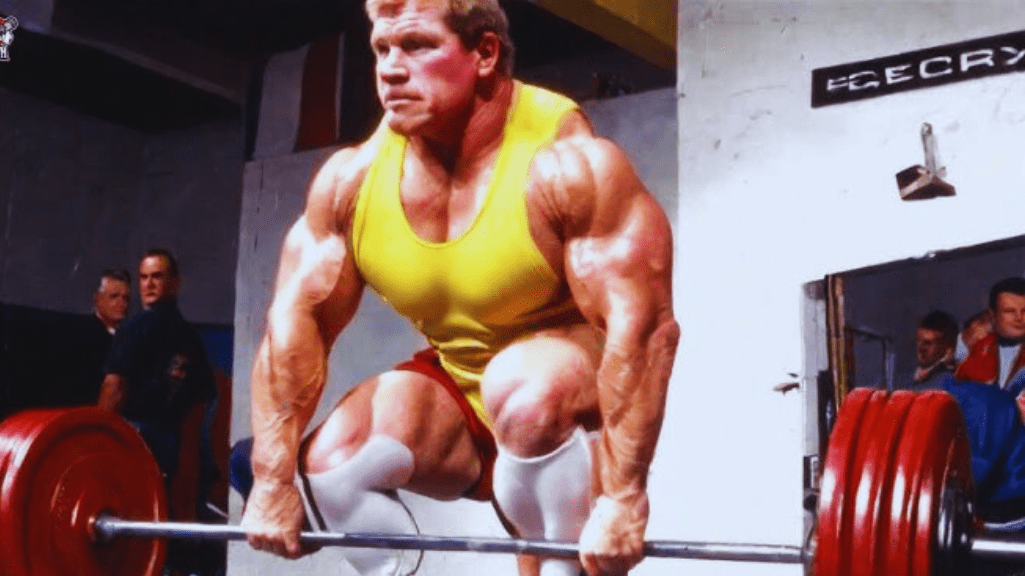
How to Be a Powerlifter: The Importance of Sticking to the Process
One of the most common pitfalls for beginners (and even intermediate lifters) is the temptation to rush the process. Powerlifting requires patience, discipline, and consistency. If you’re wondering how to be a powerlifter and achieve lasting results, the secret lies in sticking to the process and trusting your programme. Rome wasn’t built in a day, and neither is a powerlifting career. Your results will not come overnight, but by staying the course, you’ll slowly but surely build strength, improve your technique, and increase your lifting capacity.
Key points to remember:
- Progress is gradual: Your progress in powerlifting may not always be immediate. Small gains add up over time.
- Trust your programming: Stick to your plan and trust that it’s designed to help you grow.
- Be patient: Consistency and dedication will get you to your goals.
Training is a journey. You may not see dramatic changes in the first few months, but that doesn’t mean you’re not progressing. Often, progress in powerlifting is gradual — the small victories will compound over time. Trust that your programming, if followed correctly, is designed to bring you closer to your goals, even if it doesn’t always feel that way. Keep putting in the work and believe in the process, and you will get stronger with every rep, every set, and every session. How to be a powerlifter? By dedicating yourself to the journey.
How to Be a Powerlifter: Tracking Progress, Staying Consistent, and Competing
Tracking your progress is crucial. Whether it’s recording the weights lifted, keeping an eye on your form, or noting your recovery, consistently measuring your improvement helps you stay motivated and see how far you’ve come. It’s easy to get discouraged if you’re only focusing on the end goal, but looking back at your progress will show you how much you’ve grown.
How to stay on track:
- Track your lifts: Keep a log of your workouts to measure your improvements.
- Monitor your recovery: Note how your body feels and any changes in energy levels to adjust training as needed.
- Celebrate small victories: Every gain, no matter how small, contributes to your overall progress.
Consistency is king when it comes to powerlifting. Just like any other discipline, the more consistent you are with your training, the more results you’ll see. It’s not about hitting personal bests every single session; it’s about showing up, following your programme, and continuing to improve over time. Remember that how to be a powerlifter is rooted in your commitment to steady, sustainable progress. Consistency means hitting your training sessions, recovering well, and sticking to your nutritional plan. It’s the small things done regularly that lead to big results.
Competing is another key milestone in your powerlifting journey. You don’t have to wait until you’re “perfect” to compete. In fact, competing as a beginner can be an incredible way to learn and grow. You’ll be able to test your progress, learn from others, and gain valuable experience on the platform. Even if you’re nervous about stepping up to the competition, remember that how to be a powerlifter includes pushing through your fears and taking part in events that will help you improve. Start local and gain confidence — every competition is a learning experience.
How to Be a Powerlifter: Share Your Journey
Powerlifting is a community-driven sport, and sharing your journey can be a great source of motivation and encouragement for others. Don’t be afraid to share your experiences, whether it’s overcoming a tough training session, hitting a new personal best, or learning something new about yourself. The more you engage, the more you’ll learn and grow as a lifter.
So, if you’re wondering how to be a powerlifter, remember that your story matters. Share your journey in the comments below and connect with others who are on the same path. Whether you’re a beginner or a seasoned lifter, your experiences can inspire and motivate others to take the next step in their own training.
FAQ: 10 Most Common Questions About How To Become A Powerlifter
1. What is the best way to start powerlifting as a beginner?
Start with the basics: focus on proper form, learn the three main lifts (squat, bench press, and deadlift), and develop a solid foundation before increasing the intensity. Consider seeking guidance from a coach if possible.
2. How often should I train to improve in powerlifting?
Aim to train each of the three main lifts 2–3 times per week. The frequency will depend on your experience level, recovery ability, and personal goals.
3. How long will it take to get strong enough to compete?
This varies greatly by individual, but with consistent effort, most lifters can compete in local meets within 1–2 years. It depends on your starting point, commitment, and consistency in training.
4. How do I prevent injuries while powerlifting?
Focus on proper technique, progressively increase weight, and incorporate warm-up and cool-down routines. Also, be sure to allow adequate recovery time between sessions.
5. Should I follow a specific powerlifting programme?
Yes, structured training plans help ensure balanced development in all three lifts. Choose a programme based on your goals (e.g., general strength or preparing for a competition) and stick with it.
6. How important is nutrition in powerlifting?
Nutrition plays a vital role. Fuel your body with enough protein, carbs, and healthy fats to support recovery and muscle growth. Stay hydrated and time your meals around your workouts for optimal performance.
7. How do I know if I’m overtraining?
Signs of overtraining include fatigue, irritability, lack of progress, and increased injury risk. If you experience these symptoms, consider taking more rest or adjusting your training load.
8. What should I do if I hit a plateau?
Plateaus are normal in powerlifting. To break through, adjust your training, incorporate variations of the main lifts, and make sure you’re getting enough rest and recovery.
9. How do I mentally prepare for heavy lifts?
Mental preparation is key. Visualisation, breathing techniques, and focusing on technique can help reduce anxiety and improve your confidence under heavy weights.
10. Can I still improve if I can’t always make it to the gym?
Yes! Consistency is more important than frequency. If you can’t make it to the gym, find ways to train at home or adjust your schedule. The key is to keep progressing, even if it’s slower than you’d like.
By now, you should have a solid foundation in how to be a powerlifter and the steps to take to get started. Don’t wait for the perfect time to begin — start today, stay consistent, and trust the process. The road may be long, but every step will bring you closer to becoming the lifter you aspire to be.
